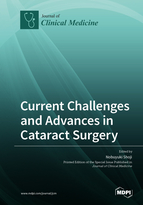Current Challenges and Advances in Cataract Surgery
A special issue of Journal of Clinical Medicine (ISSN 2077-0383). This special issue belongs to the section "Ophthalmology".
Deadline for manuscript submissions: closed (20 July 2022) | Viewed by 22288
Special Issue Editor
Interests: multifocal IOL; EDOF IOL; toric IOL; MIGS; glaucoma surgery
Special Issue Information
Dear Colleagues,
Cataract surgery has achieved rapidly advancing development for several years. It is no longer enough to simply remove the lens opacity and insert an intraocular lens with a good focus somewhere; we are now in an era where strict predictive accuracy and a high quality of vision is required. In addition, there are more and more situations where cataract surgery must be performed on patients who have already undergone other ophthalmic surgeries in the past—in other words, after refractive surgery, after corneal endothelial surgery, and after glaucoma filtration surgery. High-quality cataract surgery is required even in these complicated cases. In this Special Issue, we would like to discuss the appropriate formulas, the appropriateness of multifocal IOL or extended depth of fucus (EDOF) IOL, and the indications for toric IOLs in previously operated eyes such as refractive surgery, corneal endothelial transplantation, and glaucoma filtering surgery. Furthermore, intrascleral IOL fixation for aphakic eyes will also be discussed.
Prof. Dr. Nobuyuki Shoji
Guest Editor
Manuscript Submission Information
Manuscripts should be submitted online at www.mdpi.com by registering and logging in to this website. Once you are registered, click here to go to the submission form. Manuscripts can be submitted until the deadline. All submissions that pass pre-check are peer-reviewed. Accepted papers will be published continuously in the journal (as soon as accepted) and will be listed together on the special issue website. Research articles, review articles as well as short communications are invited. For planned papers, a title and short abstract (about 100 words) can be sent to the Editorial Office for announcement on this website.
Submitted manuscripts should not have been published previously, nor be under consideration for publication elsewhere (except conference proceedings papers). All manuscripts are thoroughly refereed through a single-blind peer-review process. A guide for authors and other relevant information for submission of manuscripts is available on the Instructions for Authors page. Journal of Clinical Medicine is an international peer-reviewed open access semimonthly journal published by MDPI.
Please visit the Instructions for Authors page before submitting a manuscript. The Article Processing Charge (APC) for publication in this open access journal is 2600 CHF (Swiss Francs). Submitted papers should be well formatted and use good English. Authors may use MDPI's English editing service prior to publication or during author revisions.
Keywords
- multifocal IOL
- EDOF IOL
- toric IOL
- refractive surgery
- DSAEK
- glaucoma filtering surgery







